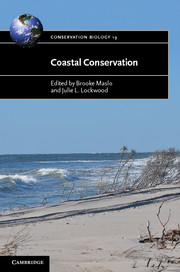Book contents
- Frontmatter
- Dedication
- Contents
- List of contributors
- List of abbreviations
- 1 The conservation of coastal biodiversity
- Part I Biodiversity Status of Coastal Habitats
- 2 Global patterns of mangrove extinction risk: implications for ecosystem services and biodiversity loss
- 3 Open-coast sandy beaches and coastal dunes
- 4 Biodiversity, ecosystem services, and the conservation of seagrass meadows
- 5 Cascading effects of global oyster reef loss on the health of estuaries
- 6 Biodiversity status of coastal dune forests in South Africa
- 7 The distribution and conservation of birds of coastal salt marshes
- Part II Emerging Threats
- Part III Synthesis
- Index
- Plate section
- References
7 - The distribution and conservation of birds of coastal salt marshes
Published online by Cambridge University Press: 05 June 2014
- Frontmatter
- Dedication
- Contents
- List of contributors
- List of abbreviations
- 1 The conservation of coastal biodiversity
- Part I Biodiversity Status of Coastal Habitats
- 2 Global patterns of mangrove extinction risk: implications for ecosystem services and biodiversity loss
- 3 Open-coast sandy beaches and coastal dunes
- 4 Biodiversity, ecosystem services, and the conservation of seagrass meadows
- 5 Cascading effects of global oyster reef loss on the health of estuaries
- 6 Biodiversity status of coastal dune forests in South Africa
- 7 The distribution and conservation of birds of coastal salt marshes
- Part II Emerging Threats
- Part III Synthesis
- Index
- Plate section
- References
Summary
Introduction
Salt and brackish coastal marshes (coastal salt marsh) are distributed thinly along the mid- to high-latitude coastlines of all the major continents except Antarctica. Where coastlines are protected and supplied with a source of sediment, grasses and shrubs colonize and stabilize the substrate, paving the way for further marsh accretion. Salt marshes form along lagoons protected by barrier islands, at the mouths of river deltas and along the edges of protected estuaries. Salt marshes are widely distributed, but account for a small amount of land cover. Although precise quantification of the current extent of salt marsh is lacking, an estimate of 60 000 km2 seems reasonable (Greenberg et al., 2006b). Salt marsh vegetation is replaced by mangrove forest between 32°N and 40°S or coexists with it at higher tidal levels (see Chapter 2). Whatever the exact amount of extant salt marsh, it is clear that it is a fraction of what existed even a century ago. The direct and indirect effects of human activity are particularly acute for salt marshes, as most of the human population lives on or near the coasts or within the watershed that feeds the estuaries where marsh grows (Rickey & Anderson, 2004).
Salt marshes show a great deal of similarity throughout the world in their simple vegetative structure punctuated by tidal sloughs and their low floristic diversity. In general, they are dominated by one to a few species of salt-tolerant grasses and shrubs (mostly of the Chenopodiaceae), often showing distinct zonation associated with the frequency of tidal inundation and salinity (Figure 7.1). However, marshes along the different continental shorelines are unique, showing differences in the dominant plant taxa, source of the colonizing fauna, specifics of the tidal regime, frequency of storm disturbance, and the tremendous variation in human activity and use. While similar to the eye, even within a region subtle differences in marsh structure give rise to distinct biotic assemblages (Figure 7.2).
- Type
- Chapter
- Information
- Coastal Conservation , pp. 180 - 242Publisher: Cambridge University PressPrint publication year: 2014
References
- 11
- Cited by

